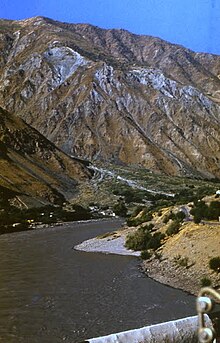Panj (river)
| Panj | |
|---|---|
 The Panj river forms much of the border between Tajikistan and Afghanistan | |
| Location | |
| Countries | Afghanistan and Tajikistan |
| Physical characteristics | |
| Source | |
| • location | confluence of Pamir and Wakhan Rivers |
| Mouth | Amu Darya |
• coordinates | 37°06′39″N 68°18′53″E / 37.11083°N 68.31472°E |
| Length | 921 km (572 mi) |
| Basin size | 114,000 km2 (44,016 sq mi) |
| Discharge | |
| • average | 1,000 m3/s (35,315 cu ft/s) |
| Basin features | |
| Progression | Amu Darya→ Aral Sea |
| Official name | Lower part of Pyandj River |
| Designated | 18 July 2001 |
| Reference no. | 1084[1] |

The Panj (Russian: Пяндж; Persian: رودخانه پنج; "River Five") (/ˈpɑːndʒ/; Tajik: Панҷ, پنج; "Five"), traditionally known as the Ochus River and also known as Pyandzh (derived from its Slavic word ("Pyandz"), is a river in Afghanistan and Tajikistan and is a tributary of the Amu Darya. The river is 921 kilometres (572 mi) long and has a basin area of 114,000 square kilometres (44,000 sq mi).[2] It forms a considerable part of the Afghanistan–Tajikistan border.[3]
The river is formed by the confluence of the
Water consumption

A water treaty between the Soviet Union and Afghanistan, signed in 1946, allows Afghanistan to draw 9 million cubic metres of water a year.[3] It currently draws 2 million cubic metres of water. According to the Panj River Basin Project, environmental damage could be expected if Afghanistan drew the entire amount of water from the river that the treaty allows.
Bridges
- US Army Corps of Engineers. The bridge replaces a barge that could transport only 60 cars a day and which was unusable many months in the year due to strong currents in the river. RAWA reports[4]that this facilitates the heroin trade, the key to the economic miracle in Afghanistan.
- Another bridge was built at the confluence with the Gunt River at Khorogin 2003.
- A bridge exists at Langar, which may still be closed.
The Aga Khan Development Network has been engaged in a project to build a series of three bridges across the Panj River between Tajikistan and Afghanistan.[5]
- The first of these bridges, connecting Emomali Rahmonov, Afghanistan's Vice-President Hedayat Amin Arsala and His Highness the Aga Khan in November, 2002.[5][6]
- This was followed by the inauguration of the
- The Ishkashim bridge between
See also
References
- ^ "Lower part of Pyandj River". Ramsar Sites Information Service. Retrieved 25 April 2018.
- ^ Пяндж (река), Great Soviet Encyclopedia
- ^ a b "Pyanj River Basin Project". Asian Development Bank. Archived from the original on February 19, 2011. Retrieved 2008-12-07.
- ^ RAWA: U.S. built bridge is windfall for Afghan drug trade
- ^ a b "Darwaz Bridge to strengthen commercial ties and Tajik-Afghan relations". Aga Khan Development Network. Archived from the original on 2012-02-13. Retrieved 2008-12-04.
- ^ "Press Release: Aga Khan and Tajik and Afghan Leaders Open Bridge into Afghanistan". Aga Khan Development Network. 2002-11-03. Archived from the original on 2006-10-10. Retrieved 2006-12-09.
- ^ "Press Release: Darwaz Bridge to strengthen commercial ties and Tajik-Afghan relations - AKDN". Aga Khan Development Network. 2004-07-06. Archived from the original on 2006-12-06. Retrieved 2006-12-09.
- ^ "Remarks by the Aga Khan at the Inauguration of the Ishkashim Bridge - AKDN, October 31, 2006". Aga Khan Development Network. 2006-10-31. Retrieved 2006-12-09.
- ^ "News: Aga Khan and President Rahmonov inaugurate reconstructed bridge in Ishkashim". Asia-Plus. 2006-10-31. Archived from the original on 2007-09-27. Retrieved 2006-12-10.
